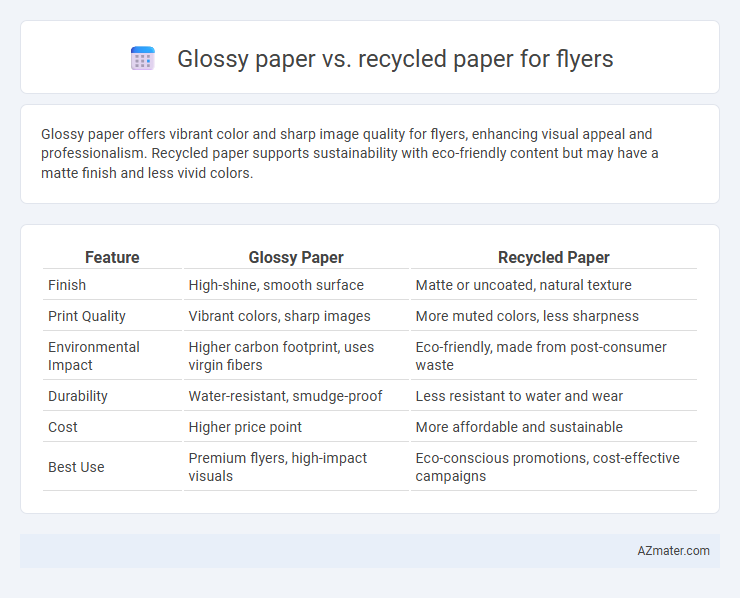Glossy paper offers vibrant color and sharp image quality for flyers, enhancing visual appeal and professionalism. Recycled paper supports sustainability with eco-friendly content but may have a matte finish and less vivid colors.
Table of Comparison
| Feature | Glossy Paper | Recycled Paper |
|---|---|---|
| Finish | High-shine, smooth surface | Matte or uncoated, natural texture |
| Print Quality | Vibrant colors, sharp images | More muted colors, less sharpness |
| Environmental Impact | Higher carbon footprint, uses virgin fibers | Eco-friendly, made from post-consumer waste |
| Durability | Water-resistant, smudge-proof | Less resistant to water and wear |
| Cost | Higher price point | More affordable and sustainable |
| Best Use | Premium flyers, high-impact visuals | Eco-conscious promotions, cost-effective campaigns |
Introduction: The Importance of Paper Choice for Flyers
Choosing the right paper for flyers directly impacts visual appeal, durability, and environmental footprint. Glossy paper offers vibrant colors and sharp details, enhancing brand presentation, while recycled paper supports sustainability goals by reducing waste and conserving resources. Understanding these benefits helps businesses align their marketing materials with both aesthetic preferences and eco-friendly values.
Understanding Glossy Paper: Features and Benefits
Glossy paper for flyers offers a smooth, shiny finish that enhances color vibrancy and sharpness, making images and text more eye-catching. Its coated surface increases durability and resistance to smudging or moisture, ideal for marketing materials requiring high visual impact. Businesses benefit from glossy paper by effectively showcasing brand quality and attracting customer attention with professional, polished prints.
Exploring Recycled Paper: Characteristics and Advantages
Recycled paper for flyers offers a sustainable alternative with a unique texture that appeals to environmentally conscious audiences. It typically features a matte finish, enhancing readability and reducing glare compared to glossy paper. Choosing recycled paper supports eco-friendly practices by lowering energy consumption and decreasing landfill waste while maintaining durability for effective flyer distribution.
Visual Impact: Print Quality on Glossy vs Recycled Paper
Glossy paper offers superior print quality with vibrant colors and sharp details, enhancing the visual impact of flyers through its smooth, reflective finish. Recycled paper tends to have a more muted texture and color tone, which can result in prints with less brightness and contrast. Choosing glossy paper maximizes eye-catching appeal, while recycled paper supports eco-friendly values but may sacrifice some visual sharpness.
Environmental Considerations: Sustainability and Eco-Friendliness
Glossy paper, often coated with plastics or chemicals, poses challenges for recycling and contributes to environmental pollution, making it less sustainable compared to recycled paper. Recycled paper for flyers reduces waste by reusing fibers and typically requires less energy and water in production, supporting eco-friendly practices. Choosing recycled paper enhances resource conservation and promotes a circular economy in print marketing efforts.
Cost Comparison: Price Differences Between Glossy and Recycled Paper
Glossy paper for flyers typically costs 20-40% more than recycled paper due to higher material and finishing expenses. Recycled paper offers a more budget-friendly printing option, with prices often 15-30% lower than gloss-coated alternatives. Businesses prioritizing cost efficiency commonly choose recycled paper to reduce overall printing budgets while supporting sustainability.
Durability and Functionality: Which Paper Lasts Longer?
Glossy paper offers superior durability and water resistance, making it ideal for flyers intended for long-term use or outdoor distribution. Recycled paper, while environmentally friendly, generally has lower durability and is more prone to wear and tear over time. For flyers requiring longevity and high-quality appearance, glossy paper remains the more functional choice.
Brand Image: How Paper Choice Reflects Your Values
Choosing glossy paper for flyers reflects a brand's commitment to premium quality and vibrant visual appeal, enhancing customer perception of professionalism and attention to detail. Recycled paper signals environmental responsibility and sustainability, aligning the brand with eco-friendly values that resonate with green-conscious consumers. This deliberate paper choice communicates core brand values, influencing audience trust and loyalty through tangible, material decisions.
Common Use Cases: When to Choose Glossy or Recycled Paper
Glossy paper is ideal for vibrant flyers requiring high-resolution images and a professional finish, commonly used in marketing campaigns, product promotions, and event advertisements. Recycled paper suits eco-conscious brands aiming to showcase sustainability in community outreach, nonprofit events, and environmentally focused promotions. Choosing between glossy and recycled paper depends on the flyer's visual impact needs and the organization's commitment to environmental responsibility.
Conclusion: Selecting the Best Paper for Your Flyer Needs
Glossy paper offers vibrant colors and sharp details ideal for high-impact flyers, enhancing visual appeal with a professional finish. Recycled paper supports eco-friendly branding and sustainability goals, appealing to environmentally conscious audiences through its natural texture and reduced environmental footprint. Choose glossy paper for striking designs that demand attention, while recycled paper suits campaigns prioritizing green values and corporate responsibility.

Infographic: Glossy paper vs Recycled paper for Flyer
 azmater.com
azmater.com